Research on Multipath Correlated Imaging with the Grayscale Target in Endoscopic Applications
Abstract
:1. Introduction
2. Model and Theoretical Analysis of Multipath Correlated Imaging
3. Numerical and Experimental Results
4. Conclusions
Author Contributions
Funding
Data Availability Statement
Conflicts of Interest
References
- Pittman, T.B.; Shih, Y.H.; Strekalov, D.V.; Sergienko, A.V. Optical imaging by means of two-photon quantum entanglement. Phys. Rev. A 1995, 52, 3429. [Google Scholar] [CrossRef]
- Strekalov, D.V.; Sergienko, A.V.; Klyshko, D.N.; Shih, Y.H. Observation of two-photon ‘ghost’ interference and diffraction. Phys. Rev. Lett. 1995, 74, 3600. [Google Scholar] [CrossRef] [PubMed]
- Abouraddy, A.F.; Saleh, B.E.; Sergienko, A.V.; Teich, M.C. Entangled-photon Fourier optics. J. Opt. Soc. Am. B 2002, 19, 1174. [Google Scholar] [CrossRef] [Green Version]
- Gatti, A.; Brambilla, E.; Lugiatio, L.A. Correlated imaging, quantum and classical. Phys. Rev. A 2004, 70, 013802. [Google Scholar] [CrossRef] [Green Version]
- Cai, Y.J.; Zhu, S.Y. Ghost interference with partially coherent radiation. Opt. Lett. 2004, 29, 2716. [Google Scholar] [CrossRef] [PubMed]
- Bennink, R.S.; Bentley, S.J.; Boyd, R.W.; Howell, J.C. Quantum and classical coincidence imaging. Phys. Rev. Lett. 2004, 92, 033601. [Google Scholar] [CrossRef] [PubMed]
- Cheng, J.; Han, S.S. Incoherent coincidence imaging and its applicability in X-ray diffraction. Phys. Rev. Lett. 2004, 92, 093903. [Google Scholar] [CrossRef] [Green Version]
- Ferri, F.; Magatti, D.; Gatti, A.; Bache, M.; Brambilla, E.; Lugiato, L.A. High-resolution ghost image and ghost diffraction experiments with thermal light. Phys. Rev. Lett. 2004, 94, 183602. [Google Scholar] [CrossRef] [PubMed] [Green Version]
- Brambilla, E.G.; Bache, M.; Lugiato, L.A. Ghost imaging with thermal light: Comparing entanglement and classical correlation. Phys. Rev. Lett. 2004, 93, 093602. [Google Scholar]
- Cheng, J.; Han, S.S. Classical correlated imaging from the perspective of coherent-mode representation. Phys. Rev. A 2007, 76, 023824. [Google Scholar] [CrossRef]
- Duan, D.Y.; Zhang, L.; Du, S.J.; Xia, Y.J. Ghost imaging with broad distance. Chin. Phys. B 2015, 24, 10203. [Google Scholar] [CrossRef]
- Nan, S.Q.; Bai, Y.F.; Shi, X.H.; Shen, Q.; Qu, L.J.; Fu, X.Q. Experimental investigation of ghost imaging of reflective objects with different surface roughness. Photonics Res. 2017, 5, 37. [Google Scholar] [CrossRef] [Green Version]
- Wang, B.W.; Fu, X.Q.; Zhu, X.N.; Shi, X.H.; Nan, S.Q. Influence of transversely inhomogeneous pseudo-thermal light source on lensless ghost imaging. Appl. Opt. 2018, 57, 5784. [Google Scholar] [CrossRef] [PubMed]
- Cao, D.Z.; Li, Q.C.; Zhuang, X.C.; Renag, C.; Zhang, S.H. Ghost images reconstructed from fractional-order moments with thermal light. Chin. Phys. B 2018, 27, 123401. [Google Scholar] [CrossRef]
- Fu, Q.; Bai, Y.F.; Hang, X.W.; Nan, S.Q.; Xie, P.Y.; Fu, X.Q. Positive influence of the scattering medium on reflective ghost imaging. Photonics Res. 2019, 7, 1468. [Google Scholar] [CrossRef]
- Gong, X.B.; Tao, M.; Su, G.; Li, B.H.; Guan, J.; Song, J.F.; Yu, S.Y.; Chen, J.; Gong, W.L.; Gao, F.L. Eeperimental investigation of anisotropic diffusion applied in ghost imaging reconstruction. Appl. Sci. 2020, 10, 6437. [Google Scholar] [CrossRef]
- Yang, D.Y.; Chang, C.; Wu, G.H.; Luo, B.; Yin, L.F. Compressive ghost imaging of the moving object using the low-order moments. Appl. Sci. 2020, 10, 7941. [Google Scholar] [CrossRef]
- Chen, X.H.; Agafonovei, I.N.; Luo, K.H.; Liu, Q.; Xian, R.; Chekhova, M.V.; Wu, L.A. High-visibility, high-order lensless ghost imaging with thermal light. Opt. Lett. 2007, 35, 1166. [Google Scholar] [CrossRef] [PubMed] [Green Version]
- Chan, K.W.C.; O’Sullivan, M.N.; Boyd, R.W. High-order thermal ghost imaging. Opt. Lett. 2009, 34, 3343. [Google Scholar] [CrossRef]
- Shapiro, H.J. Computational ghost imaging. Phys. Rev. A 2008, 78, 061802. [Google Scholar] [CrossRef]
- Gao, C.; Wang, X.Q.; Cai, H.J.; Ren, J.; Liu, J.Y.; Yao, Z.H. Influence of random phase modulation on the imaging quality of computational ghost imaging. Chin. Phys. B 2019, 28, 020201. [Google Scholar] [CrossRef]
- Ferri, F.; Magatti, D.; Lugiato, L.A.; Gatti, A. Differential ghost imaging. Phys. Rev. Lett. 2010, 104, 253603. [Google Scholar] [CrossRef] [Green Version]
- Zhao, S.M.; Zhuang, P. Correspondence normalized ghost imaging on compressive sensing. Chin. Phys. B 2014, 23, 054203. [Google Scholar] [CrossRef]
- Shi, X.H.; Huang, X.W.; Nan, S.Q.; Li, H.X.; Bai, Y.F.; Fu, X.Q. Image quality enhancement in low-light-level ghost imaging using modified compressive sensing method. Laser Phys. Lett. 2018, 15, 045204. [Google Scholar] [CrossRef]
- Gazit, S.; Szameit, A.; Eldar, Y.C.; Segev, M. Super-resolution and reconstruction of sparse sub-wavelength images. Opt. Express 2009, 17, 23920. [Google Scholar] [CrossRef] [PubMed] [Green Version]
- Erkmen, B.I. Computational ghost imaging for remote sensing. J. Opt. Soc. Am. A 2012, 29, 782. [Google Scholar] [CrossRef]
- Pelliccia, D.; Rack, A.; Scheel, M.; Cantelli, V.; Paganin, D.M. Experimental x-ray ghost imaging. Phys. Rev. Lett. 2016, 117, 113902. [Google Scholar] [CrossRef] [Green Version]
- Chen, S. X-ray ghost images could cut radiation doses Technique points to safer medical imaging done with cheap, single-pixel cameras. Science 2018, 359, 1452. [Google Scholar] [CrossRef] [PubMed]
- Zhang, P.L.; Gong, W.L.; Sheng, X.; Huang, D.J.; Han, S.S. Improving resolution by the second-order correlation of light fields. Opt. Lett. 2009, 34, 1222. [Google Scholar] [CrossRef]
- Gong, W.L.; Han, S.S. Experimental investigation of the quality of lensless super-resolution ghost imaging via sparsity constraints. Phys. Rev. A 2012, 376, 1519–1522. [Google Scholar] [CrossRef] [Green Version]
- Li, H.G.; Wang, Y.; Zhang, R.X.; Zhang, D.J.; Liu, H.C.; Li, Z.G.; Xiong, J. Robust reflective ghost imaging against different partially polarized thermal light. Opt. Commun. 2018, 410, 867–870. [Google Scholar] [CrossRef]
- Lan, M.Y.; Guan, D.; Gao, L.; Li, J.H.; Yu, S.; Wu, G.H. Robust compressive multimode fiber imaging against bending with enhanced depth of field. Opt. Express 2019, 27, 12957. [Google Scholar] [CrossRef] [PubMed]
- Berizzi, F.; Diani, M. Multipath effect on ISAR image reconstruction. IEEE Trans. Aerosp. Electron. Syst. 1998, 34, 645. [Google Scholar] [CrossRef]
- Leigsnering, M.; Ahmad, F.; Ahmad, M.; Amin, M.; Zoubir, A. Multipath exploitation in through-the-wall radar imaging using sparse reconstruction. IEEE Trans. Aerosp. Electron. Syst. 2014, 50, 920. [Google Scholar] [CrossRef]
- Gennarelli, G.; Soldovieri, F. Multipath ghosts in radar imaging: Physical insight and mitigation strategies. IEEE J. Sel. Top. Appl. Earth Observ. Remote Sens. 2015, 8, 1078. [Google Scholar] [CrossRef]
- Lo, T.; Litva, J. Low-angle tracking using a multifrequency sampled aperture radar. IEEE Trans. Aerosp. Electron. Syst. 1991, 27, 797–805. [Google Scholar] [CrossRef]
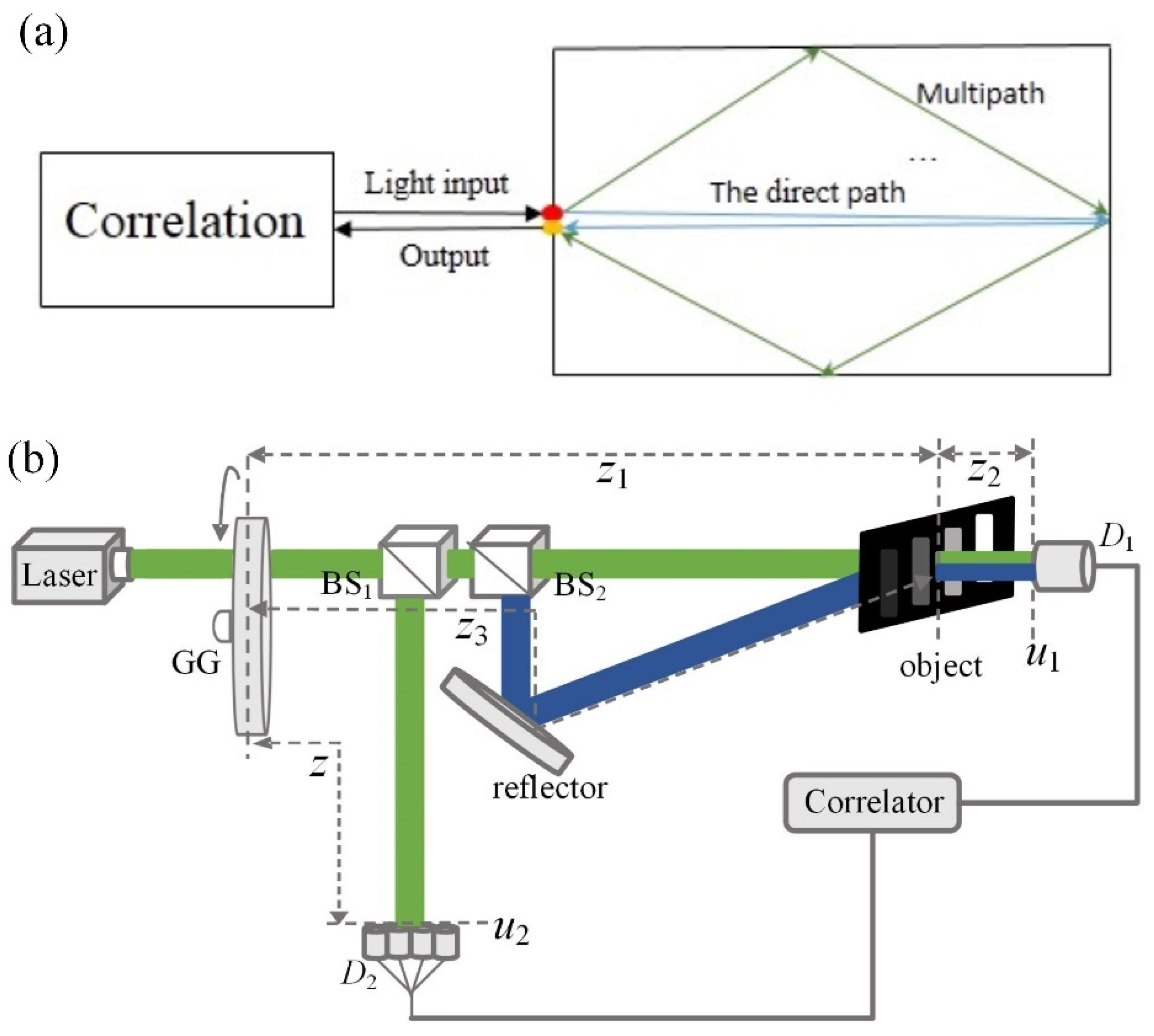
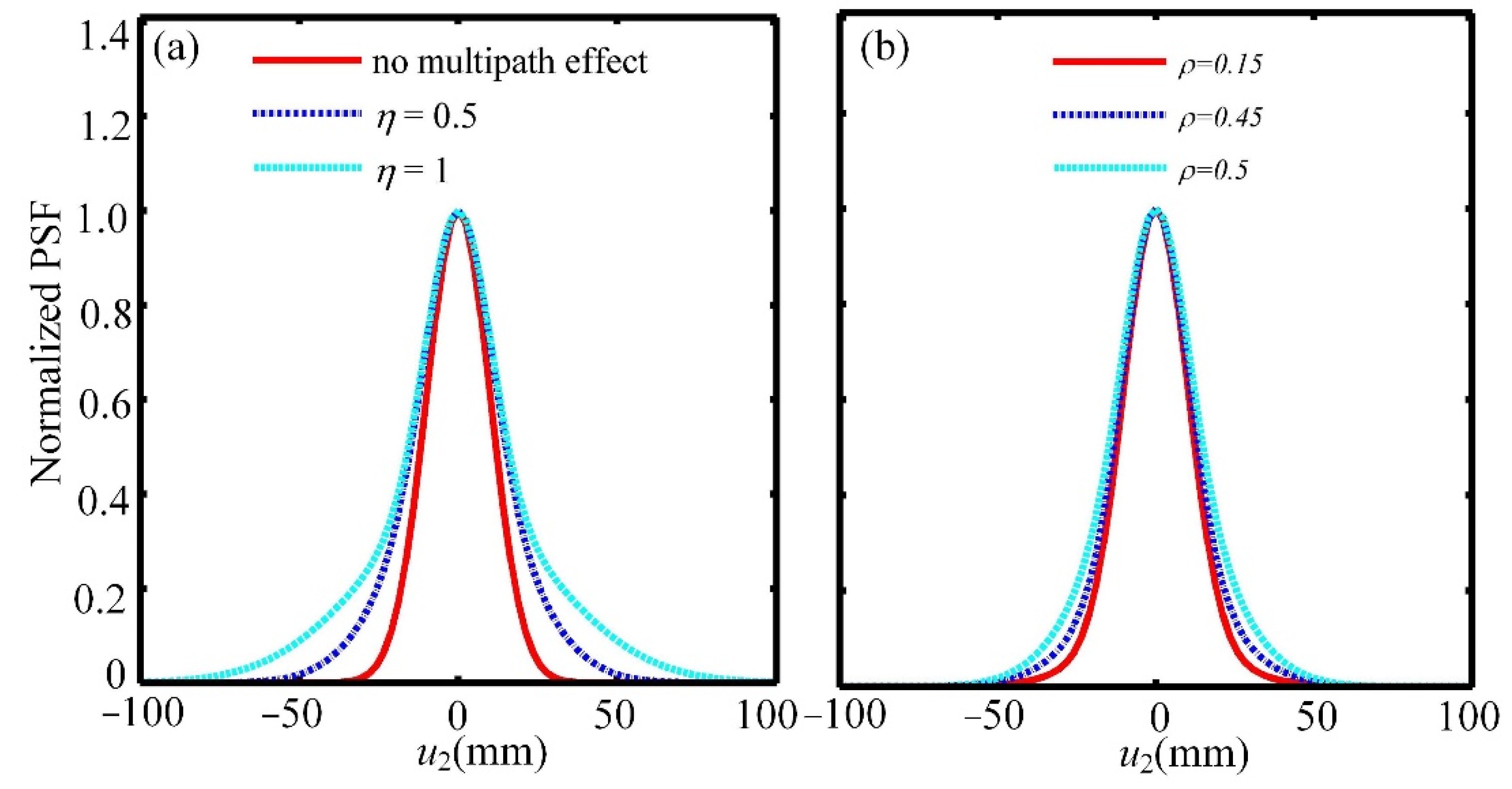
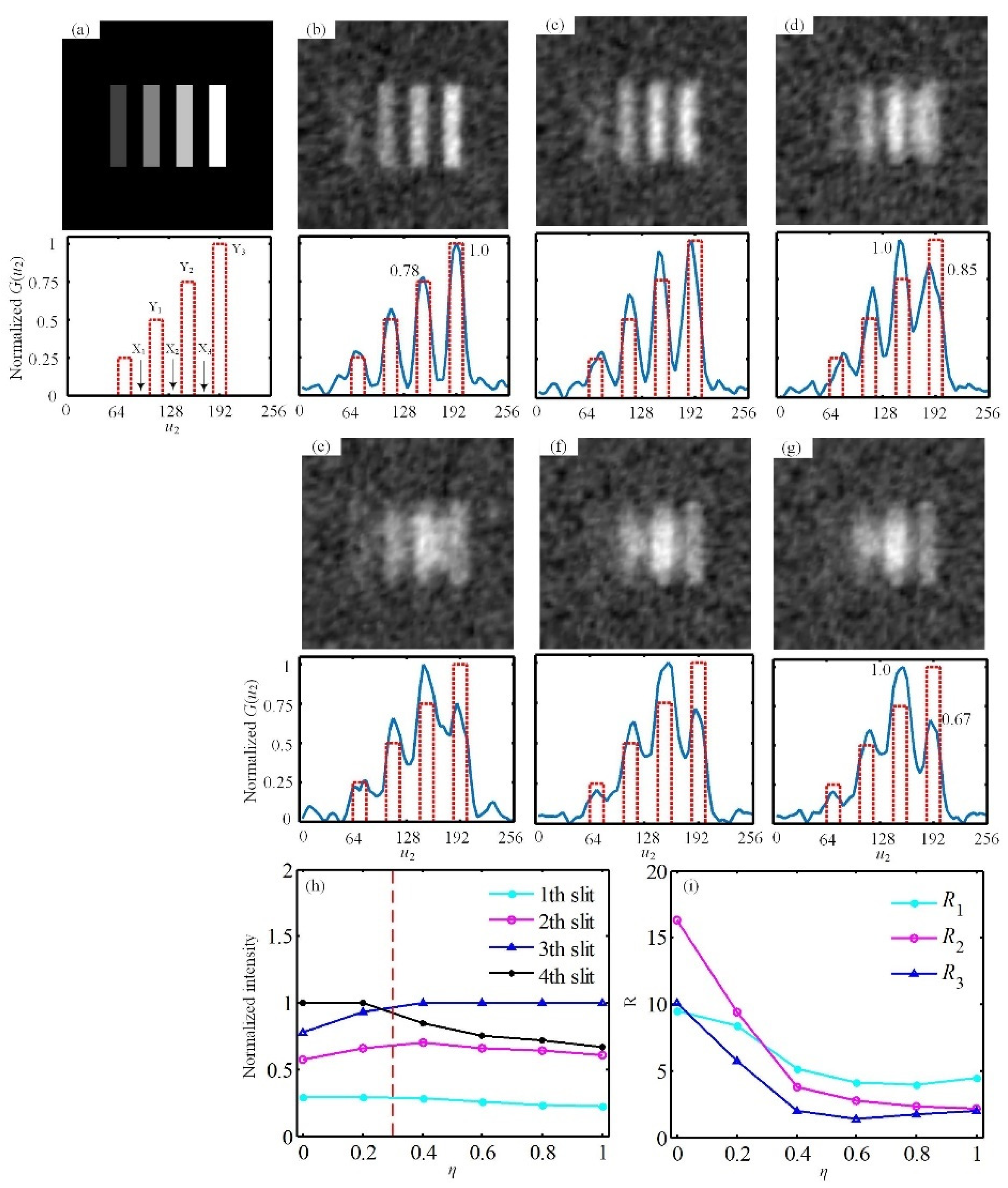
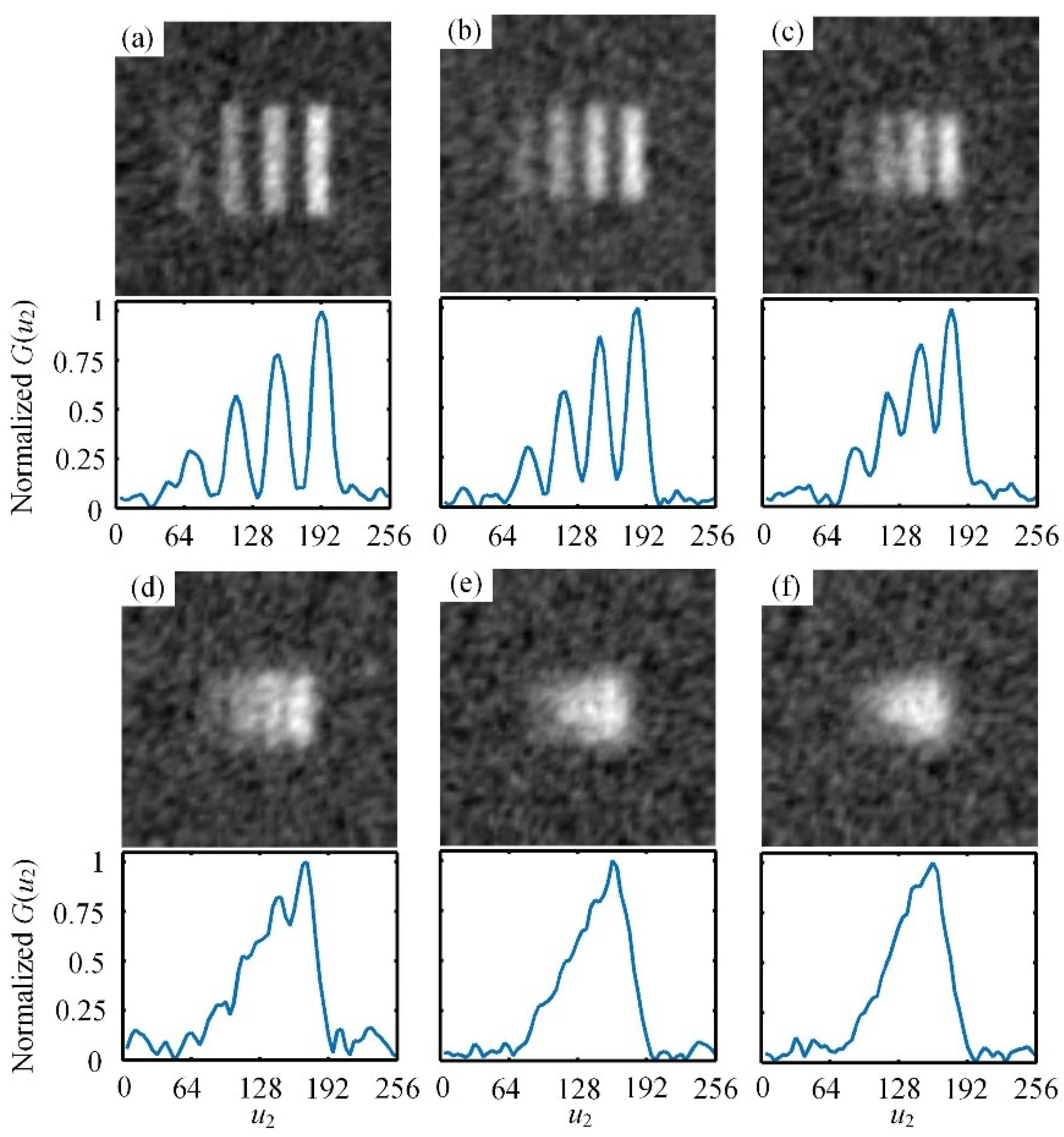
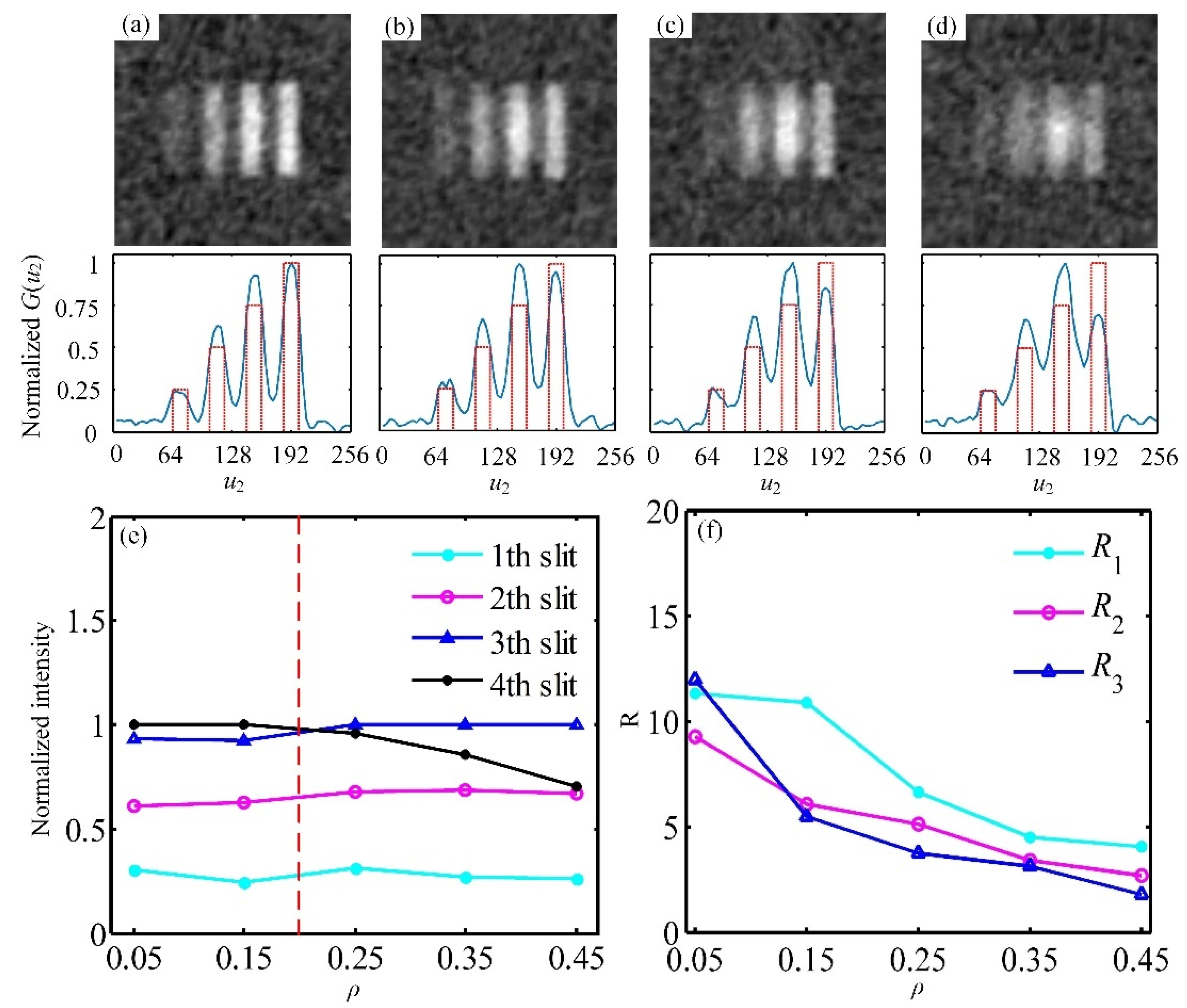
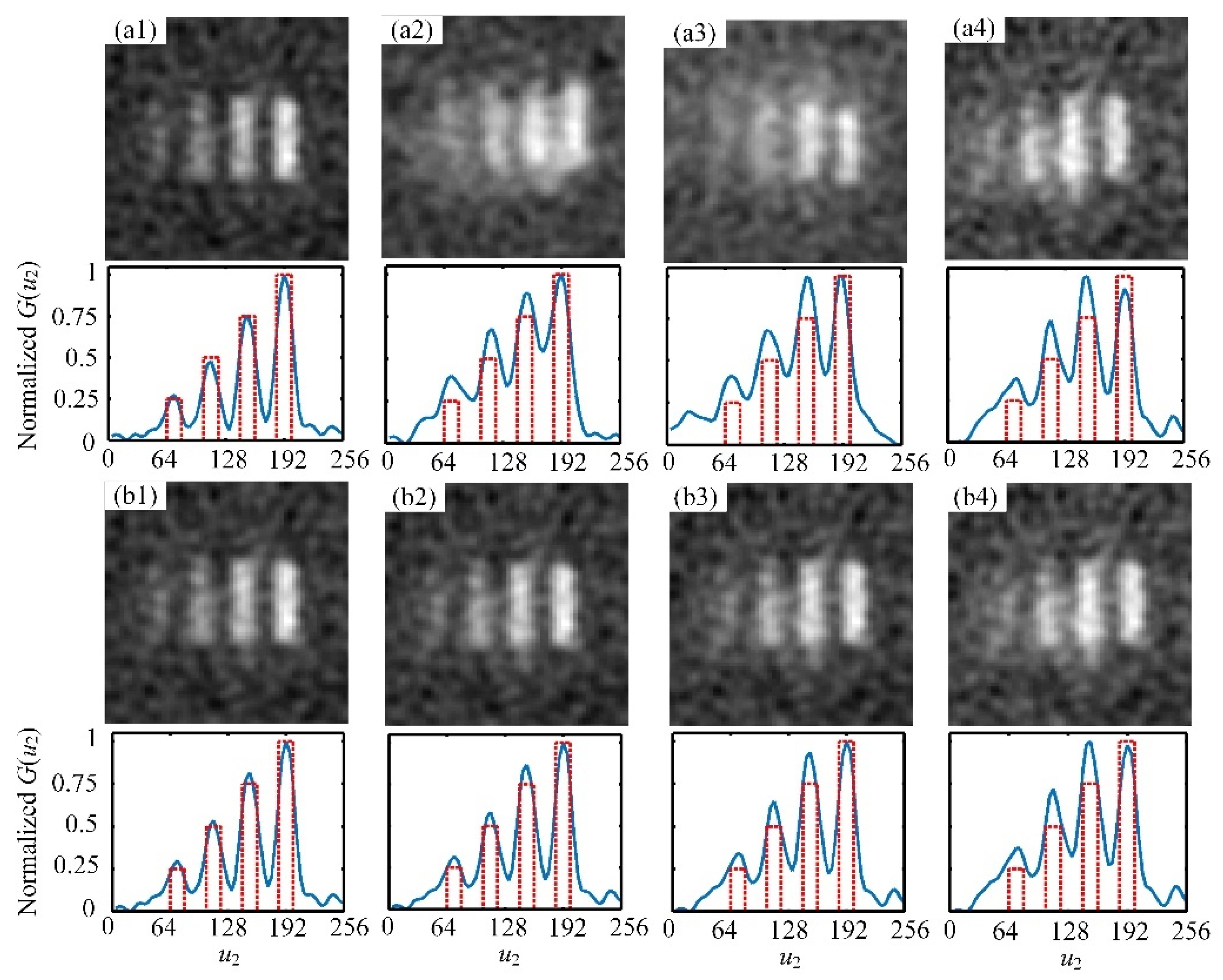
Publisher’s Note: MDPI stays neutral with regard to jurisdictional claims in published maps and institutional affiliations. |
© 2021 by the authors. Licensee MDPI, Basel, Switzerland. This article is an open access article distributed under the terms and conditions of the Creative Commons Attribution (CC BY) license (https://creativecommons.org/licenses/by/4.0/).
Share and Cite
Liu, J.; Bai, Y.; Huang, X.; Tan, W.; Nan, S.; Zou, X.; Fu, X. Research on Multipath Correlated Imaging with the Grayscale Target in Endoscopic Applications. Appl. Sci. 2021, 11, 4115. https://doi.org/10.3390/app11094115
Liu J, Bai Y, Huang X, Tan W, Nan S, Zou X, Fu X. Research on Multipath Correlated Imaging with the Grayscale Target in Endoscopic Applications. Applied Sciences. 2021; 11(9):4115. https://doi.org/10.3390/app11094115
Chicago/Turabian StyleLiu, Jiejie, Yanfeng Bai, Xianwei Huang, Wei Tan, Suqin Nan, Xuanpengfan Zou, and Xiquan Fu. 2021. "Research on Multipath Correlated Imaging with the Grayscale Target in Endoscopic Applications" Applied Sciences 11, no. 9: 4115. https://doi.org/10.3390/app11094115



